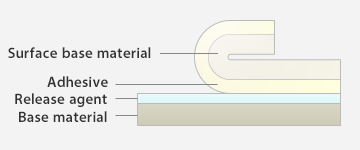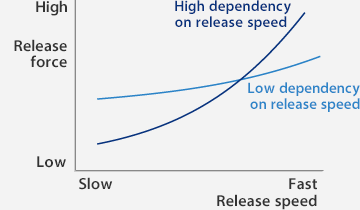- HOME
- Products
- Release papers and films
- Product construction
Release papers and films are not only protection of adhesive layer, but also have an important part in quality and function of the product itself. With variations of surface characteristics, they are also used for resin film foaming applications and so forth.
- Product construction
- Classification of release agents (silicone and little-silicone)
- Types and characteristics of release papers and films
- Physical properties of the representative silicone
- Release speed and release force
Product construction
- Release paper

- Release film

There are two types of base materials: a paper and a film. For each product, a release agent is coated on the respective side of the base material. In general, a barrier layer is pre-coated for release paper in order to prevent the release agent soaking into the base paper.
Classification of release agents (silicone and little-silicone)
The release agents that are coated on the release papers and film are broadly classified into silicone and little-silicone categories. There have been growing needs for little-silicone release agents in various industry segments including the electronic components industry.
Silicone
Release agents used for general adhesive products. LINTEC has an abundant variety of formulations based on long-time experience accumulated in the release papers and film industry.
Little-silicone
Used mainly for electronic device applications where silicone can be detrimental.
Also, fluorine release agent is available for silicone adhesives. LINTEC will offer a broad range of little-silicone release agent products ranging from light to heavy release property to cover the growing needs in the future.
Various release agents specially customized for your needs are available.
Types and characteristics of release papers and films
LINTEC takes advantage of manufacturing from the base paper, release papers and films, and even adhesive materials by own productions as total technology, which enables to produce right release property to meet customer’s requirement.Representative compositions and features are explained here.
Compositions and features of the representative release papers
| Types | Structure | Property |
|---|---|---|
| Glassine direct type | Heat resistance and optical transparency | |
| Barrier resin laminated type |  |
Waterproof property, and selective surface property*1 |
| Barrier resin coated type |  |
Heat resistance and dimensional stability |
 |
Little-silicone migration, resin coatability | |
| Curl prevention type |  |
Curl prevention, and selective surface properties*1 |
- *1When PE is selected for barrier layer, surface properties can be selected from super mirror, semi-mirror and matte type.
- Printing is possible for all types of release paper. In addition to this, LINTEC will propose various combinations upon requests.
- Types and properties of base paper
LINTEC, being engaged in the production of base paper by own machinery, can propose wide selections of base paper and offers a suitable one for release paper along with applications and demanded function.
| Types | Properties |
|---|---|
| High quality paper |
|
| Glassine paper |
|
| Kraft paper |
|
Types and properties of the representative release films
| Types | Structure | Property |
|---|---|---|
| Silicone type |  |
Cleanliness |
Cleanliness and little silicone |
||
| Anchor coat type |  |
Cleanliness, prevention of static charge, improvement of adhesion of release agent etc. |
- LINTEC release films are manufactured in clean environment. Each type of product permits printing on the release film. LINTEC proposes various combinations besides the above.
Physical properties of the representative silicone
| Name of release agents | Release force(mN/50mm)*1 | |
|---|---|---|
| Release speed:0.3m/min | Release speed:30m/min | |
| LT-H | 66 | 270 |
| LT | 74 | 290 |
| GS-H | 83 | 390 |
| GS | 88 | 430 |
| 1030 | 87 | 400 |
| 1031 | 92 | 420 |
| 2070 | 108 | 480 |
| 1010 | 177 | 550 |
| 1031A | 188 | 660 |
| 2010 | 196 | 570 |
| 2090 | 265 | 690 |
- Above figures are measured values; they are not guaranteed.
- *1Release property against Acrylic adhesive (peeling face material side, release angle is 180 degree. After coating acrylic adhesive on release film and cure for 2 minutes at 100℃, A polyester film 25μ will be applied. Measuring release property after leaveing the sample for 24 hours at 40℃ with the pressure of 40g/cm2.
Release speed and release force
The resistance, occurred when adhesive surface of a sticker or label separates from release papers or films, is called release force. The unit is expressed in (N/m) etc, and it is generally measured under 180° tape peel condition with range from low speed peeling at 0.3m/min to high speed peeling at 100m/min.
Release force is generally said to be dependent on the peeling speed, and it tends to be heavier as the peeling speed increases. However, LINTEC can propose suitable products, such as those that are less dependent on the peeling rate, from among the ample formulations of release agents.
- Measurement of release force (180°tape peel)
-


Contact Us
For product inquiries, please use the entry form or contact the following address.
- LINTEC Corporation Converted Products Operations
- PHONE: +81-3-3868-7721
FAX: +81-3-3868-7728
8th Fl., Bunkyo Garden Gate Tower, 1-1-1 Koishikawa, Bunkyo-ku, Tokyo 112-0002, Japan